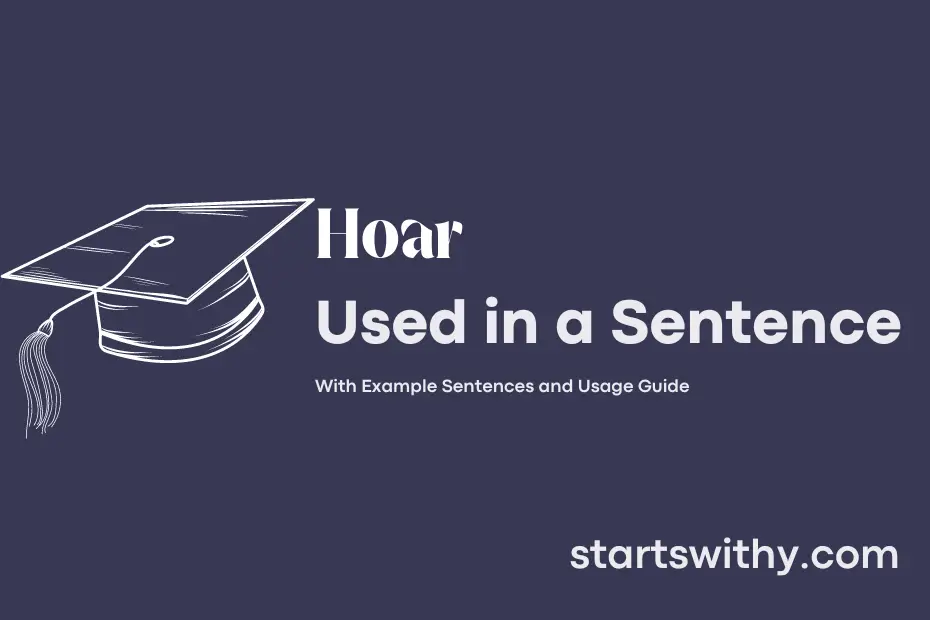Ever wondered what the word “hoar” means in the English language? The term “hoar” is not commonly used in everyday conversations, but its unique and poetic nature can add depth and richness to your writing.
“Hoar” is an adjective that describes something covered in frost or appearing white or gray due to age or weathering. This word evokes imagery of a frosty winter morning or of something ancient and weathered by time. Its unusual usage can bring a sense of nostalgia or antiquity to your writing, making it a valuable addition to your vocabulary arsenal.
7 Examples Of Hoar Used In a Sentence For Kids
- Hoar frost makes the grass sparkle in the morning.
- The old man’s beard turned hoar with age.
- I like to draw patterns in the hoar frost on the window.
- The winter morning was covered in a blanket of hoar frost.
- The tree branches were coated in a layer of hoar frost.
- The spiderwebs were covered in delicate hoar frost.
- The car was covered in a layer of hoar frost on cold mornings.
14 Sentences with Hoar Examples
- Make sure to wake up early to catch the hoar of the morning before heading to your classes.
- The campus looked magical with a layer of hoar covering the trees and grass.
- Don’t forget to bundle up with warm clothes to beat the hoar in the early morning lectures.
- Walking on the hoar-covered pathways can be slippery, so be careful.
- Studying in the library with a view of the hoar outside can be quite peaceful.
- The early morning football match was canceled due to the thick hoar on the ground.
- The college canteen serves hot chai to help students warm up during the hoar mornings.
- The cricket practice had to be moved indoors due to the hoar making the pitch too slippery.
- Wearing gloves is essential to keep your hands warm during the hoar winter mornings.
- The art students were inspired by the intricate patterns created by the hoar on the windows.
- The college groundskeeper was out early in the morning, clearing the hoar off the walkways.
- The group of friends decided to have a hoar fight before starting their study session.
- The students were excited for the annual trek to experience the hoar-covered mountains.
- The campus security reminded students to be cautious while walking on the hoar-covered pathways.
How To Use Hoar in Sentences?
Hoar can be used in a sentence as follows: “The hoar frost on the trees glistened in the early morning light.” In this sentence, “hoar” is used to describe the frost that has formed on the trees, giving it a noticeably white and icy appearance.
When using hoar in a sentence, it is important to remember that it is an adjective that describes something that is white, gray, or frost-covered, typically due to age or cold weather. You can use hoar to describe objects, landscapes, or even people’s appearances.
To use hoar correctly in a sentence, identify the object or subject you want to describe and determine if it fits the qualities associated with hoar – white, gray, or frost-covered. Then, place hoar before the noun you are describing to provide more detail and enhance your sentence.
Remember that hoar is not a commonly used word in everyday language, so it may be most appropriate in creative writing, poetry, or descriptive passages. By incorporating hoar into your vocabulary and writing, you can add depth and vivid imagery to your descriptions.
Conclusion
In conclusion, the examples of sentences featuring the keyword “hoar” demonstrate its versatile usage in describing frost-covered landscapes or aged appearances. From “The trees were draped in hoar frost, shimmering in the morning light” to “Her hoar hair hinted at a life rich in experiences,” this word can vividly paint images of both physical and metaphorical frostiness. Whether evoking a wintry scene or conveying a sense of age and wisdom, “hoar” adds descriptive depth and richness to the sentences where it appears.
Overall, the sentences utilizing “hoar” showcase its ability to enhance the imagery and tone of written expression. By incorporating this word thoughtfully, writers can evoke various sensations and evoke vivid mental images that resonate with readers, ultimately enhancing the overall quality and impact of their writing.



